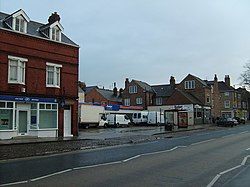Clifton, York
| Clifton | |
|---|---|
 |
|
| Clifton shown within North Yorkshire | |
| Population | 13,548 (2011. Ward) |
| OS grid reference | SE592532 |
| Civil parish |
|
| Unitary authority | |
| Ceremonial county | |
| Region | |
| Country | England |
| Sovereign state | United Kingdom |
| Post town | YORK |
| Postcode district | YO30 |
| Dialling code | 01904 |
| Police | North Yorkshire |
| Fire | North Yorkshire |
| Ambulance | Yorkshire |
| EU Parliament | Yorkshire and the Humber |
| UK Parliament | |
Clifton is a suburb of York in the unitary authority of the City of York, in the north of England about 1½ miles from the city centre. The A19, passes north out of York through Clifton.
The old village area was made a Conservation Area in 1968. It is the location of Nestle Foods Factory and the Public Schools of St Peter's and the former Queen Anne's.
The origin of the name is derived from the Olde English pre-7th century clif, meaning a gentle slope, or more usually a riverbank, with tun, an enclosure or settlement.
During Roman times there was a road through Clifton that approached the Roman fortress from the north-west and headed towards the river crossing. There was a second road that also left the north-west gate and may eventually have joined the other. The evidence from early timber buildings from the Museum gardens and early burials from Bootham and Clifton suggest the roads existed from the 1st century. Sporadic 2nd century Roman occupation material and fragments of streets indicate that by that time expansion may have begun in Clifton. This development was not sustained and evidence indicates that from the 3rd century onwards the area beyond St. Mary's was given over to cemeteries.
There are records that show a windmill existed from the late 14th to the early 19th centuries in Burton Stone Lane and was known as Clifton or Lady Windmill. Ownership was recorded between 1374 and 1413 as belonging to John de Roucliff. Other owners recorded were Sir William Ingleby, in the mid 15th century, and Sir William Robinson in the early 18th century. The last record of the mill still being operational was in 1852, but there is no trace of the building now.
Horse racing had begun in York towards the end of the 17th century. In 1708 the corporation recognised the potential for profit from horse racing and that local Clifton landowner, Sir William Robinson, had offered his land on Clifton and Rawcliffe Ings as a racecourse, donated £15 a year towards a plate. Following the winter of 1730 racing moved to the recently drained Knavesmire.
The York Diocesan Church Building Society, founded in 1861, contributed to the building of the church in Clifton between 1867 and 1869.
Clifton is a ward in the Unitary Authority of the City of York. As of 2015, it is represented by Danny Myers and Margaret Wells, both of whom are members of the local Labour Party.
...
Wikipedia

